Más Cultura venezolana || More Venezuela Culture
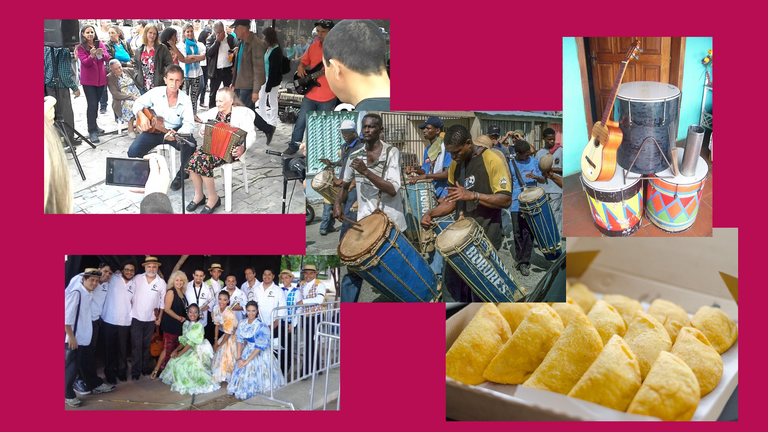
Si hay algo que tiene abundante Venezuela, es su riqueza cultural. Una mezcla de culturas que se inició con los indígenas nativos y la conquista de estas tierras por parte de los españoles, luego con la traída de los esclavos africanos. Esto fue el punto de partida para este mestizaje que muchos años después fue ampliándose al iniciarse la explotación petrolera, a finales del siglo XIX, el éxodo de una Europa en guerra y el resto de movilizaciones migratorias regulares que se dan en el mundo.
English version below
Esto ha traído como resultado que tengamos tradiciones netamente indígenas, con todo su carácter ancestral; mientras en otras regiones, la tradición africana es predominante, en creencias, manifestaciones artísticas, alimentación, etc. La presencia de elementos árabes en la cultura venezolana, también ha sido objeto de estudio, la cual se explica por la dominación árabe, durante ocho siglos, en la zona sur de España.
A diferencia de esas raíces, la indígena, hispánica y africana, tenemos casos tan particulares como lo es la Colonia Tovar, un enclave de colonos alemanes, con cerca de 180 años en el país, que aún conservan su idioma (el cual ha tenido una evolución distinta al de Alemania), junto a vestimentas y tradiciones traídas de la Selva Negra y que persisten en el lugar. Todo esto junto a las interesantes mezclas que se han dado al fundirse algunas de estas manifestaciones con otras autóctonas de Venezuela, que han dado frutos como el joropo coloniero, una de las variantes menos conocidas del venezolanísimo joropo, que se toca con acordeón.
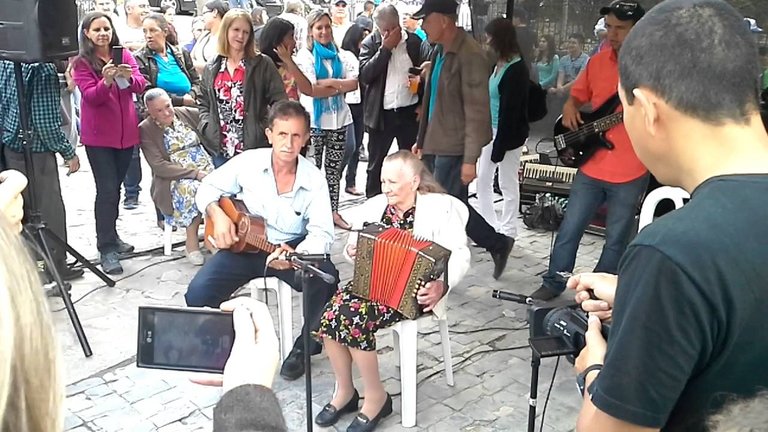
Joropo Coloniero
Fuente || Source
En otro campo tenemos casos tan curiosos como el que se produjo en el estado Bolívar, a donde fueron llegando, en busca de oro: ingleses, franceses, brasileños y vecinos de las islas Trinidad y Tobago, así como de otras islas del Caribe. Allí nació una variante local de Patois, que mezcla el español, inglés, francés y hasta algo de holandés.
Un detalle significativo de esta experiencia es que la música predominante de la región, es el calipso, de origen antillano. Esta música, que estaba prohibida en las islas, tuvo que sacrificar sus instrumentos originales, por la persecución (principalmente de la Iglesia), y fue cuando empezó a tocarse con los barriles que conforman el Steel Band. Pero a diferencia de su lugar de origen, en Venezuela se sigue tocando con los tambores bumbac, pues acá no hubo esa prohibición.
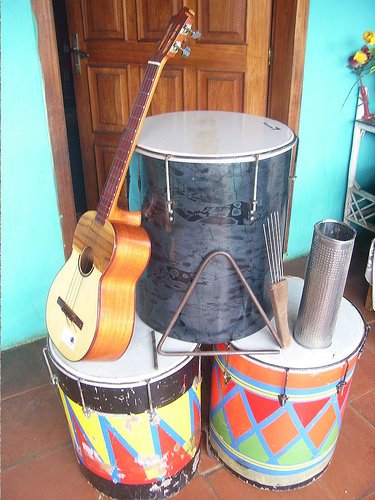
Instrumentos del Calipso
Fuente || Source
De la variedad de ritmos de tambores de ascendencia africana, solo diré que la mayoría de las personas no tienen ni un poco de idea de lo amplio que es. Es así que confunden manifestaciones tan distintas entre sí, como un golpe de tambor a San Juan, una fulía o una parranda. Pero esto se debe, en gran medida, a que hay poca difusión de la información y que esta es muy amplia.
Yo recuerdo en los años setenta haber visto un registro de más de 360 formas musicales en Venezuela y sé muy bien que aquella lista no estaba completa, así que ustedes podrán imaginarse.
Sin embargo, el caso que a mi me parece que debería contar con mucha más difusión, es la relacionada con la cultura caraqueña. Pues siendo la capital, con elementos culturales tan particulares, es increíble que aún hoy en día haya mucha gente que la desconoce por completo.
Tal es el caso de la Canción Serenatera, la música cañonera, y en el campo teatral: el sainete. Afortunadamente, en el plano gastronómico, la ciudad ha sido más afortunada, y aunque hay algunos platos que se consumen en todo el país y ahora también en otras partes del mundo, solo suele ignorarse que su origen es caraqueño.
Tenemos que estar agradecidos de poder tener tantas expresiones culturales en esta tierra, solo falta darle mucho más difusión, que es lo que logra la permanencia en el tiempo y nos crea el arraigo hacia nuestra ciudad, hacia nuestro país.
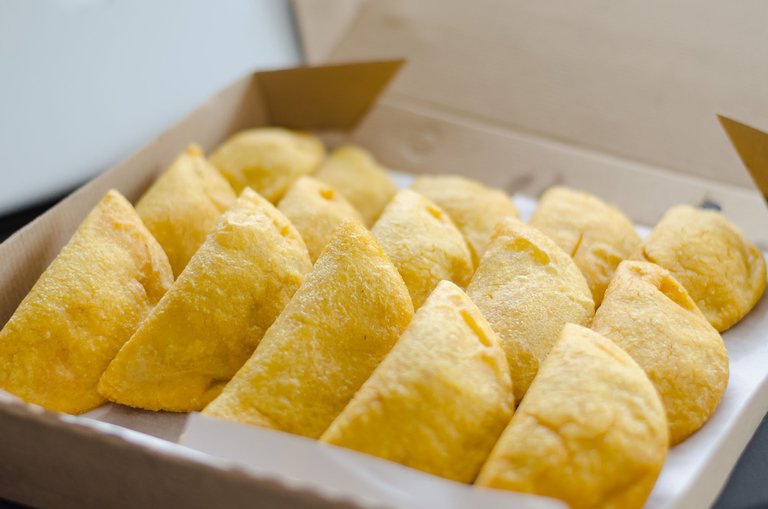
Empanadas
Fuente || Source
English
If there is one thing Venezuela has in abundance, it is its cultural richness. A mixture of cultures that began with the native Indians and the conquest of these lands by the Spaniards, then with the arrival of African slaves. This was the starting point for this mixture that many years later was expanded with the beginning of oil exploitation at the end of the 19th century, the exodus from a Europe at war and the rest of the regular migratory movements that take place in the world.
This has brought as a result that we have purely indigenous traditions, with all their ancestral character; while in other regions, the African tradition is predominant, in beliefs, artistic manifestations, food, etc. The presence of Arab elements in the Venezuelan culture has also been an object of study, which is explained by the Arab domination, during eight centuries, in the southern area of Spain.
In contrast to these roots, the indigenous, Hispanic and African, we have particular cases such as the Tovar Colony, an enclave of German settlers, with nearly 180 years in the country, who still preserve their language (which has had a different evolution from that of Germany), along with clothing and traditions brought from the Black Forest and that persist in the place. All this together with the interesting mixtures that have occurred when some of these manifestations have merged with other native Venezuelan manifestations, which have given fruits such as the colonial joropo, one of the lesser known variants of the very Venezuelan joropo, which is played with accordion.
In another field we have such curious cases as the one that took place in the state of Bolivar, where the English, French, Brazilians and neighbors from the islands of Trinidad and Tobago, as well as from other Caribbean islands, arrived in search of gold. There, a local variant of Patois was born, which mixes Spanish, English, French and even some Dutch.
A significant detail of this experience is that the predominant music of the region is calypso, of Antillean origin. This music, which was forbidden in the islands, had to sacrifice its original instruments, due to persecution (mainly from the Church), and that is when it began to be played with the barrels that make up the Steel Band. But unlike its place of origin, in Venezuela it is still played with the bumbac drums, because here there was no such prohibition.
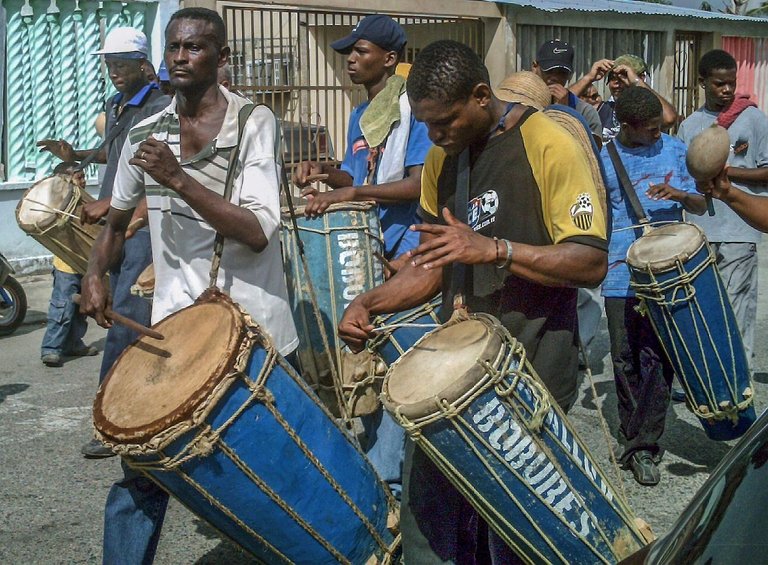
Chimbańgueles - San Benito
Fuente || Source
Of the variety of drum rhythms of African descent, I will only say that most people have no idea of how wide it is. So they confuse manifestations as different from each other, as a drum beat to San Juan, a fulia or a parranda. But this is due, to a great extent, to the fact that there is little diffusion of information and that it is very broad.
I remember in the seventies having seen a record of more than 360 musical forms in Venezuela and I know very well that that list was not complete, so you can imagine.
However, the case that seems to me that should have much more diffusion, is the one related to the culture of Caracas. Being the capital city, with such particular cultural elements, it is incredible that even today there are many people who are completely unaware of it.
Such is the case of the Serenatera Song, the Cañonera music , and in the theatrical field: the sainete (one-act farce). Fortunately, in the gastronomic field, the city has been more fortunate, and although there are some dishes that are consumed throughout the country and now also in other parts of the world, it is usually ignored that their origin is from Caracas.
We have to be grateful to have so many cultural expressions in this land, we just need to give it much more diffusion, which is what achieves permanence over time and creates the roots to our city, to our country.

Música cañonera
Fuente || Source


Vote la-colmena for witness
By @ylich
https://twitter.com/3916290856/status/1619238231975022592
The rewards earned on this comment will go directly to the people( @ylich ) sharing the post on Twitter as long as they are registered with @poshtoken. Sign up at https://hiveposh.com.
Su post ha sido valorado por @goya
¡Muy agradecido por el apoyo! ¡Me alegra verlos por acá! 🤗
Fabuloso post maestro @ylich, la relevante diversidad cultural es muestra del una geografía cultural extraordinarias. la fiesta de los Carnavales del Callao es patrimonio cultural de la humanidad declaratoria de la UNESCO. En el Calipso está presente el cuatro venezolano y el idioma patua.
Excelente.
Gracias por ser feliz.
¡Muchas gracias, amigo mío!
Creo que la última frase de su comentario fue lo que más me gustó 😉
Estas recibiendo un voto por parte del proyecto "Sound Music" (@music1sound) y este post fue seleccionado para el reporte de curación diaria. Contáctenos para saber más del proyecto a nuestro servidor de Discord. Si desea delegar HP al proyecto: Delegue 5 HP - Delegue 10 HP - Delegue 20 HP - Delegue 30 HP - Delegue 50 HP - Delegue 100 HP.
¡Muchas gracias por el apoyo!